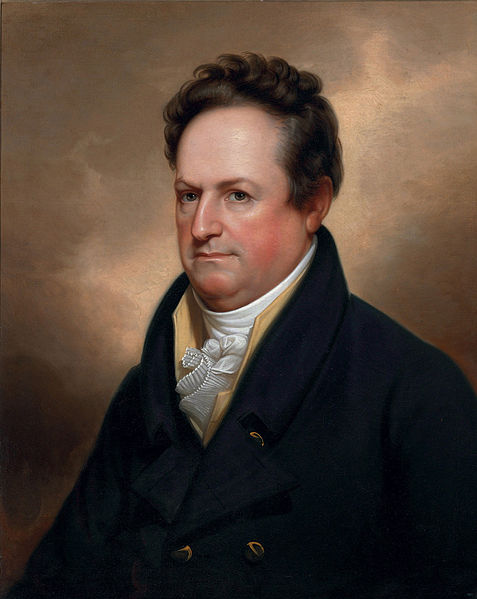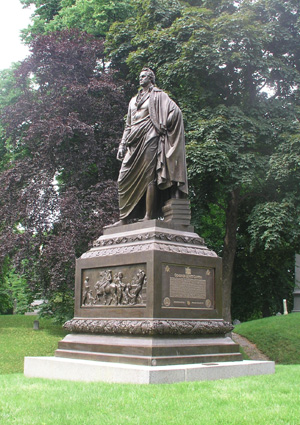<Back to Index>
- Physicist Boris Borisovich Galitzine, 1862
- Composer Bedřich Smetana, 1824
- 6th Governor of New York DeWitt Clinton, 1769
PAGE SPONSOR


DeWitt Clinton (March 2, 1769 – February 11, 1828) was an early American politician who served as United States Senator and the sixth Governor of New York. In this last capacity he was largely responsible for the construction of the Erie Canal. Clinton was the leader of New York's People’s Party, and was a major rival of Martin van Buren, who was attorney general of New York during Clinton's governorship. According to Daniel Walker Howe (2007) Clinton is an authentic but largely forgotten hero of American democracy. Howe explains, "The infrastructure he worked to create would transform American life, enhancing economic opportunity, political participation, and intellectual awareness."
DeWitt Clinton was the second son born to James Clinton and his wife Mary DeWitt (1737 – 1795, aunt of Simeon De Witt), and was educated at what is now Columbia University. He became the secretary to his uncle, George Clinton, who was then governor of New York. Soon after he became a member of the Democratic - Republican Party. He was a member of the New York State Assembly in 1798, and of the New York State Senate from the Southern District from 1798 to 1802, and from 1806 to 1811. He was a delegate to the New York State Constitutional Convention in 1801. He was a member of the Council of Appointments in 1801 - 1802 and 1806 - 1807.
He won the by-election for U.S. Senator from New York after the resignation of John Armstrong, Jr. and served from February 23, 1802, to November 4, 1803. He resigned, unhappy with living conditions in newly built Washington, DC, and was appointed Mayor of New York City. He served as Mayor in 1803 - 1807, 1808 – 1810, and 1811 - 1815. While serving as Mayor, he organized the Historical Society of New York in 1804 and was its president. He also helped re-organizing the American Academy of the Fine Arts in 1808 served as its president between1813 and 1817. He was Regent of the University of New York from 1808 to 1825.
He was married twice. On February 13, 1796, he married Maria Franklin, daughter of the prominent New York Quaker merchant,
Walter Franklin. By her he had ten children, four sons and three
daughters surviving at the time of her death in 1818. On May 8, 1819,
he married Catharine Jones, daughter of a New York physician, Thomas
Jones; she outlived her husband. His son, George William Clinton (1807 – 1885), served as Mayor of Buffalo, New York, 1842 - 1843. From 1810 to 1824, he was a member of the Erie Canal Commission.
He was among the first members, appointed in 1810, who projected and
surveyed the route to be taken. After 1816, he became the driving force
during the construction of the canal. In 1811, the death of John Broome left a vacancy in the office of Lieutenant Governor of New York. In a special election, Clinton defeated the Federalist Nicholas Fish and the Tammany Hall candidate Marinus Willett, to become Lieutenant Governor under Governor Daniel D. Tompkins until the end of the term in June 1813. In 1812, Clinton ran for President of the United States as candidate for both the Federalist Partyand a small group of anti-war Democratic - Republicans. In the close Election of 1812, Clinton was defeated by President Madison; Clinton received 89 electoral votes to
James Madison's 128. It was the strongest showing of any Federalist
candidate for the Presidency since 1800, and the change of the votes of
one or two states would have given Clinton the victory. After the resignation of Governor Tompkins, who had been elected Vice President, he won a special gubernatorial election in which he was the only candidate. 1,479 votes were cast for Peter Buell Porter - against Clinton's 43,310 - because the Tammany organization, which fiercely hated Clinton, had printed ballots with Porter's name
and distributed among the Tammany followers in New York City. On July
1, 1817, Clinton took office as Governor of New York.
He was re-elected in 1820, defeating the sitting Vice President
Tompkins in a narrow race - DeWitt Clinton 47,447 votes, Tompkins
45,900 - and served until December 31, 1822. During his second term, the New York State Constitutional Convention of
1821 shortened the gubernatorial term to two years, and moved the
beginning of the term from July 1 to January 1, actually cutting off
the last 6 months of the 3 year term he had been elected to. Also the
gubernatorial election was moved from April to November, but Clinton
was not renominated by his party to run for re-election in November
1822. Even so, he still kept his post as President of the Erie Canal Commission. In April 1824, a majority of his political enemies, the Bucktails, voted in the New York State Legislature for
his removal from the Canal Commission. This caused such a wave of
indignation among the electorate, that he was nominated for Governor by
the "People's Party", and was re-elected governor, against the official
candidate of the Democratic - Republican Party, fellow canal commissioner Samuel Young. He served another two terms until his sudden death in office. He was originally buried at the Clinton Cemetery in Little Britain, New York, later he was re-interred at the Green - Wood Cemetery in Brooklyn, New York.
Clinton was able to accomplish many things as a leader in civic and
state affairs, such as improving the New York public school system,
encouraging steam navigation, and modifying the laws governing
criminals and debtors. The 1831 DeWitt Clinton locomotive was
named in his honor. The community of Whitestone, New York, was for
several decades after his death known as Clintonville, but reverted to
its traditional name; however, the governor is memorialized to this day
by Clintonville street, a major local road.
While governor, Clinton was largely responsible for the construction of the Erie Canal. He was persuaded by Canal proponent Jesse Hawleyto support construction of a canal from the eastern shore of Lake Erie to the upper Hudson River. Many thought the project was impracticable, and opponents mocked it as "Clinton's Ditch". But
in 1817, he got the legislature to appropriate $7,000,000 for
construction. When the Canal was finished in 1825, Governor Clinton
opened it, sailing in the packet boat Seneca Chief along
the Canal into Buffalo. After sailing from the mouth of Lake Erie to
New York City he emptied two casks of water from Lake Erie into New York Harbor,
celebrating the first connection of waters from East to West. The Canal
was an immense success, carrying huge amounts of passenger and freight
traffic. It provided cheap transportation from the Atlantic to the
West, drawing traffic to New York state and New York City, which became
the most important state and city in America.